Operation of the Homeless Persons Legislation in Scotland: 2012-13
This bulletin provides information on homelessness applications, assessments and outcomes to 31 March 2013. It includes information on the characteristics of applicant households, local authority assessments and the action taken in respect of cases that were concluded. Snapshot data on households in temporary accommodation at 31 March 2013 are presented and notifications of households at risk of homelessness due to eviction/repossession.
4. Assessments
The national indicator
4.1. Table 1 provides the main summary statistics on the progress of homelessness applications, analysed by the year in which the application was received by the council. The year of application is also the basis by which we measure progress against the national indicator - "Improve access to suitable housing options for those in housing need"[5]. However, it takes time for councils to assess a homelessness application. As a consequence, 1,188 applications in 2012-13 have yet to be assessed.
4.2. Of the 39,827 applications in 2012-13 for which assessment details have been received, 31,058 were assessed as homeless or potentially homeless and 29,728 were assessed as priority need. (Table 1). Those with a priority need assessment represent 96% of those assessed as homeless, an increase of five percentage points over 2011-12. The percentage of homeless assessed as priority has increased by 23 percentage points since 2003-04 and by 19 percentage points since 2006-07.
The 2012 homelessness commitment: National picture
4.3. The Homelessness etc. (Scotland) Act 2003 set the objective that by 31 December 2012 all homeless applicants would be entitled to settled accommodation. This objective is generally referred to as the 2012 homelessness commitment. Up to 31 December 2012 those with a priority need assessment who were unintentionally homeless were entitled to settled accommodation, while those assessed as non-priority were entitled to temporary accommodation, advice and assistance only. Progress towards the commitment has been tracked by the number and proportion of homeless applicants assessed as priority; with the aim that 100% of homeless would be assessed as priority from 31 December 2012.
4.4. In November 2012 the Scottish Parliament approved the Homelessness (Abolition of Priority Need Test) (Scotland) Order 2012 which gave effect to the commitment. From 31st December 2012 all unintentionally homeless households are entitled to settled accommodation.
4.5. Chart 11 shows, for Scotland as a whole the proportions of homeless assessed as priority in each quarter from April - June 2002 in the lead up to the change. The chart shows fairly steady increase in the priority share of homelessness assessments between Summer 2006 and Summer 2012. The rate of progress was a little faster over the last two quarters before the legislative change was implemented.
Chart 11: Scotland: Percentage of homeless applicants assessed as priority homeless
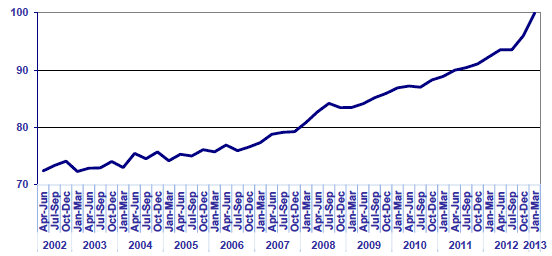
Key features of the period up to implementation of the commitment
4.6. To provide a clearer picture of patterns of assessment the remainder of this section presents analyses of assessments based on the year the assessment was made, rather than the year of application.
4.7. In 2012-13, councils assessed 31,964 applications as either homeless or threatened with homelessness. This is a decrease of 3,747 (a 10% decrease) since 2011-12. The reduction in assessments reflects the reduction in applications discussed in the previous section.
4.8. Of the 31,964 homeless assessments in 2012-13, 30,583 (96%) were assessed as priority need. Nationally the proportion of homeless/ threatened with homelessness assessed as being in priority need has increased each year since 2002-03.
4.9. Chart 12 shows the impact of the move towards the 2012 commitment on the number and characteristics of households with a priority need[6]. In 2000-01, the largest group in priority need were single parent households with parent aged 26 or over. By 2012-13, single people aged between 26 and retirement were the largest group, their numbers having increased from a little over 5,000 in 2000-01 to around 11,500 in 2012-13.
Chart 12: Number of applicants assessed as priority need by broad household type: Scotland: 2000-01 and 2012-13
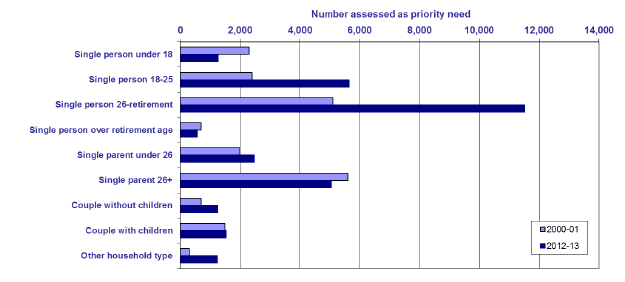
4.10. As the number and proportion of priority assessments has increased the number of non-priority assessments has fallen - from around 10,800 in 2002-03 to a little over 1,300 in 2012-13. Table 6d shows that, of the 1,381 non-priority homeless assessments in 2012-13, 1,036 (75%) were single men without dependants. A further 254 (18%) were single women, with another 70 (5%) being couples without children and the remaining 21 being other households without children.
4.11. Prior to the abolition of the priority need test, homelessness legislation also prescribed particular circumstances in which a homeless household should be accorded priority need status. Following abolition, local authorities have decided to continue to monitor these additional household characteristics, although these no longer form part of the homelessness assessment. Reflecting this (Chart 13 and Table 6c) shows that:
- Of the 3,646 applications assessed as homeless in 2012-13 where the main reason for presenting as homeless was a violent or abusive dispute within the household, 3,636 (99.7%) were assessed as priority homeless.
- Of the 553 homeless households where the main reason for presenting as homeless was harassment, 546 (98.7%) were accorded priority.
- Of 746 homeless households fleeing non-domestic violence, 738 (98.9%) were assessed as priority.
4.12. There were 227 households assessed as homeless where the main reason for presenting was the loss of service/ tied accommodation, of whom 209 (92.1%) were assessed as priority. It should be noted that 2012/13 shows some non-priority assessments as local authorities were entitled to apply the priority need test until 30th December 2012.
Chart 13: Applications assessed in 2012-13 by main reason for application: Scotland
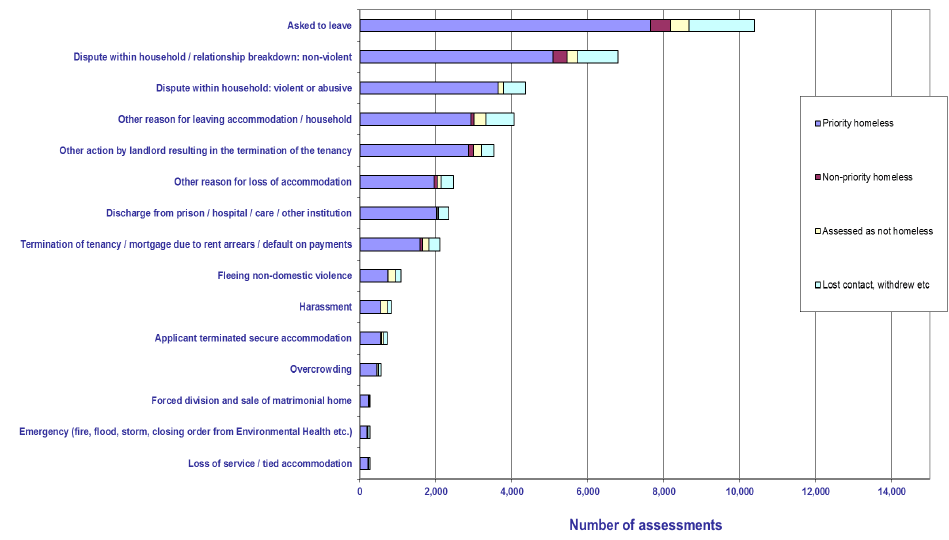
The 2012 homelessness commitment: Progress by local authority area
4.13. In their December 2005 statement on progress towards the 2012 commitment Scottish Ministers chose not to prescribe nationally the ways in which priority categories should be extended. Instead the Government left it to individual councils to set their own plans and to widen priority categories according to local policy[7]. Paragraph 4.15 below discusses some of the factors which may have affected local policies.
4.14. Table 6a shows each council's progress towards the 2012 commitment annually from 2011-12. Table 6b gives the quarterly position for each council over the past two years. Key points are:-
- In the latest quarter January - March 2013, following the approval by the Scottish Parliament of the Homelessness (Abolition of Priority Need Test) (Scotland) Order 2012 all Scottish local authorities assessed 100% of homeless households as being in priority need.
4.15. As noted in paragraph 4.14 councils have been free to determine the speed at which they move towards the target of assessing all homeless as priority. In addition to councils' own policies and priorities, there are a number of factors which will have affected councils' decisions over the period since the commitment was entered into. These factors include:
- The supply of available lets in the local authority area: In some areas councils may have judged that at particular times they had insufficient lets to meet the additional needs for social housing for priority homeless households from widening the priority criteria when set against the needs of others to whom they had a statutory duty to re-house. This may be due to a shortage of supply in some areas or difficulty in accessing a sufficient supply of lets from some RSL partners.
- The impact of homelessness prevention. Reductions in homelessness from increased prevention reduces the total need for social lets for homeless households. Over the period councils have adopted, developed and implemented housing options and prevention work at different times and at different speeds. Over the past few years following the formation of the housing options hubs, homelessness prevention has had a significant impact in most local authority areas. It is notable that in the last two years, while the percentage of homeless assessed as priority has increased the number of priority assessments decreased in 24 of Scotland's 32 local authorities.
- The need for and availability of temporary accommodation. Once a priority need assessment is made, local authorities have a duty to provide temporary accommodation until suitable settled accommodation can be secured. As a result, priority need cases may spend much longer in temporary accommodation. For some local authorities the pace at which priority need categories were extended may have been constrained by the need to procure additional units of suitable temporary accommodation.
4.16. The Scottish Parliament's Infrastructure and Capital Investment Committee's 2011-12 inquiry into the 2012 commitment gives a useful insight into the issues surrounding the 2012 commitment. The written evidence provided by local authorities and other bodies details the types of issues which councils have faced, and are facing, in moving towards meeting the target. All this information can be found on the Scottish Parliament's website at ICI Committee Evidence and Report.
Chart 14: Percentage of homeless assessed as priority: Jan to Mar: 2013
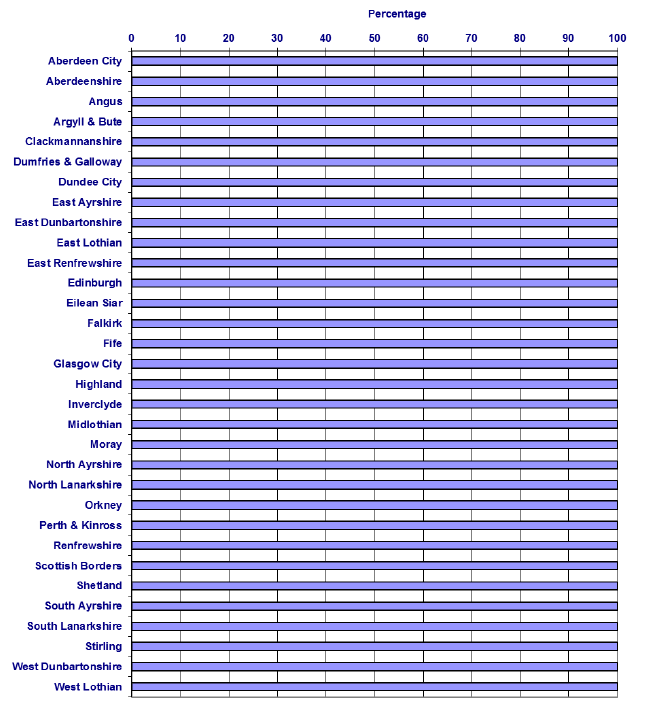
4.17. For applicants assessed as being in priority need, councils record reasons why the household has priority. However since abolition, local authorities have decided to continue to monitor these additional household characteristics for those assessed as homeless or threatened with homelessness, although these no longer form part of the homelessness assessment. Councils have identified at least one reason for the priority assessment, but more than 1 reason can be given.
4.18. The other main reasons[8] for priority assessments in 2012-13 were that the household had dependent children (29% of all priority assessments), the household was fleeing domestic violence or abuse (10%), mental illness or personality disorder of a household member (10%) and a household member vulnerable for other special reasons (16%). Nearly 39% of priority assessments in 2011-12 were because of local policy compared with 8% in 2007-08, the first year this category was identified in the statistics (Chart 15).
4.19. In 2012-13, 39% of priority assessments were made 'according to local policy'. This proportion has been increasing in each year from 8% in 2007-08 the first year this category was identified in the statistics. As explained in paragraph 4.13 above, the proportion 'according to local policy' has been growing as councils have developed and implemented local policies to extend the scope of priority assessments in moving to achieve the 2012 homelessness commitment.
Chart 15: Scotland: Reasons for priority assessment: 2012-13
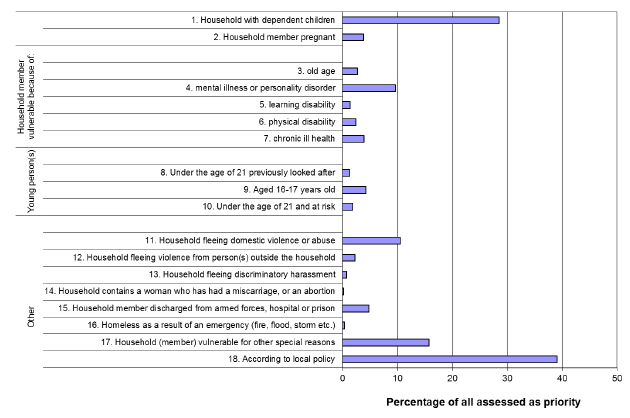
Repeat homelessness
4.20. The percentage of homeless assessments identified as repeat cases (i.e. where a previous application from the household had been closed less than 12 months before the current assessment[9]) has fallen from 9.8% in 2002-03 to 5.5% in 2012-13. (Chart 16)
4.21. Comparing rates of repeat homelessness by household type, 8% of assessments by single males were repeat applications, 6% of assessments by single females were repeats, while single parents and couples with or without children had lower rates of repeat homelessness.
4.22. The rate of repeat homelessness varies by local authority area, from 10.6% in Dumfries & Galloway to around 1% in Perth & Kinross (Chart 17).
Chart 16: Scotland: Percentage of repeat homelessness assessments
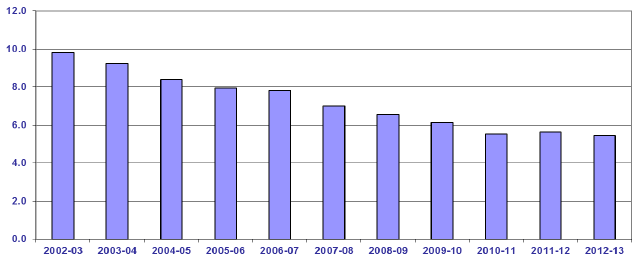
The chart shows for each year the percentage of assessments where the applicant household was assessed as homeless or threatened with homelessness, had previously applied and been assessed as homeless or threatened with homelessness and whose previous application had been closed within 12 months of their current application.
Chart 17: Repeat homelessness assessments as a percentage of all assessments by local authority area: 2012-13
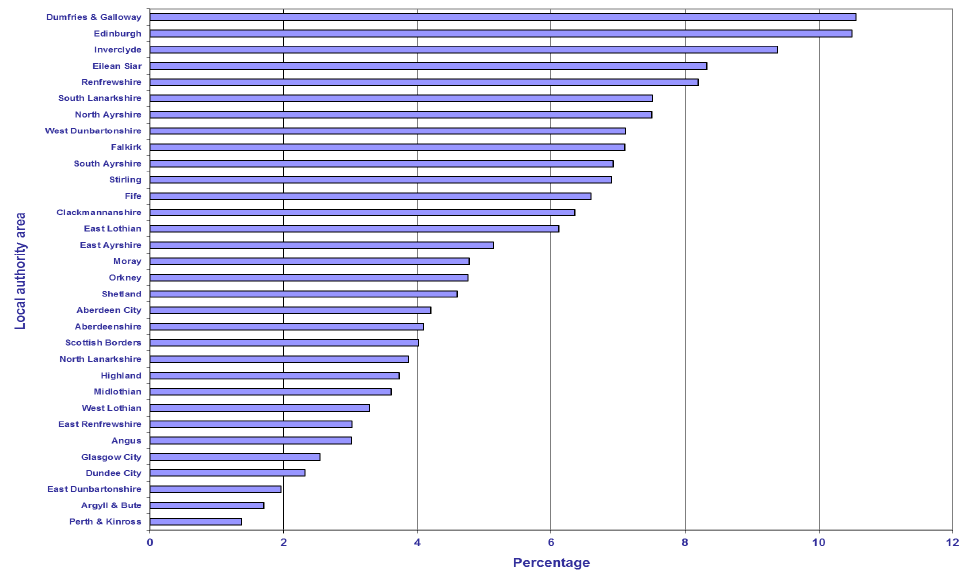
Intentionality Decisions
4.23. Cases assessed as homeless (or threatened with homelessness) and in priority need[10] are also tested as to whether they made themselves homeless intentionally. Chart 17b shows the proportion of such cases assessed as intentionally homeless or threatened with homelessness. Important points to note are, for Scotland:-
- The proportion of cases assessed as intentionally homeless or threatened with homelessness has been increasing - from 3% during January-March 2005 to nearly 6% during January-March 2013.
- The number assessed as intentionally homeless is at its highest level since January-March 2002. In the most recent quarter (Jan-Mar 2013) 439 cases were assessed as intentionally homeless. This compares with a low of 233 cases during January-March 2005.
- Although the numbers are small, the number of intentionality decisions has been increasing, whilst the number of applications and homeless assessments have both been reducing.
Chart 17b: Intentionality Decisions
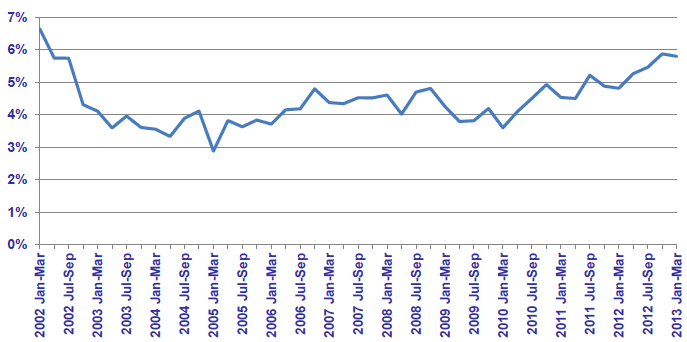
Support needs of homeless households
4.24. Of the 31,964 households assessed as homeless in 2012-13, 10,830 (34%) were assessed as having one or more support needs. (Table 7 and Chart 18) A higher proportion of applicants in priority need (35%) were assessed as having one or more support needs. Of those with support needs, 4,181 (13% of all assessed as homeless) required support because of mental health, 4,069 (13%) required support on skills for independent living and 3,571 (11%) required support because of alcohol or dependency problems.
Chart 18: Identified support needs of homeless households: Scotland: 2012-13
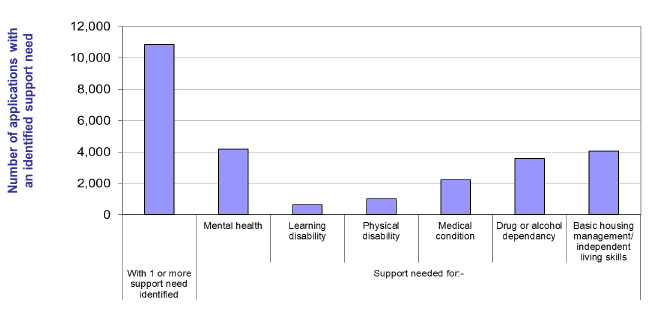
Contact
There is a problem
Thanks for your feedback